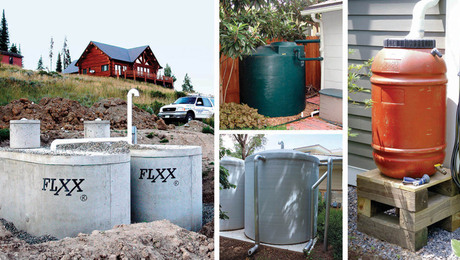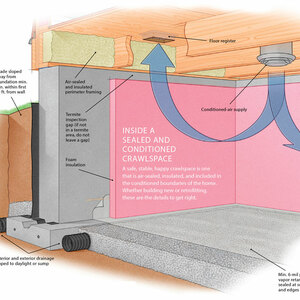My house built in 1974 with one HVAC unit for whole house. So poorly insulated they added a second unit to do the upstairs and I found the ducts going from the crawlspace up to the second floor. I am fixing the problem with the insulation and have already made a HUGE improvement and not even done yet.
Both heat pumps are old and need to be replaced. For some reason the couple of HVAC companies I talked to said they don’t do zoned systems and want to just replace with two new heat pumps. Is there some GOOD reason for this or am I just getting cynical and think they don’t want to sell me some cheap electronic components when they think they can talk me into a 2nd heat pump.
Steve.


















Replies
I was discussing this w/ an HVAC guy for my two story house. The main issue that comes in to play w/ zonging dampers vs seperate condensers & air handlers is system sizing. (which is what I suspected when I asked in the first place).
Suppose you have one system w/ zone dampers. That system is sized to condition the entire house - not just for cooling, but for comfort - which involves the removal of humidity.
Suppose it's a hot & muggy summer night, you have the temp set higher downstairs, & set at your desired temp upstairs where the bedrooms are.
Since the system is designed to condition an entire house, it will cool it to the set temperature upstairs before it is able to remove the humidity, so you will not be comfortable.
The better design is to have two separate systems - each sized properly for the zone it will be conditioning. This will maximize efficiency.
That analysis is very simple-minded. It applies only to very basic systems. Explain to your "HVAC guy" that two-stage, variable speed systems are perfectly capable of handling a variable load demand, whether it comes from cooling different numbers of rooms or the same number of rooms at various load conditions.
In other words, cooling 6 rooms vs 12 is analogous to cooling always 10 rooms but at different outside temps. Being able to modulate the cooling capacity and fan speed is always beneficial to interor comfort and humidity removal.
In the end, one zoned or 2 separate systems can both achieve the same results when done competently, and the cost difference is not as great as you may think.
The single zoned system requires more expertise, so careful with contractor selection.
DG/Builder
I have to agree with dgbldr.
Find an HVAC contractor that will do the load calculations on your home, and design a system to meet your requirements. Wheather it is a single unit, zoned system, or two seperate systems is a call you will be able to make after seeing the calculations.
Design temperatures for your area, house oreintation, number, sizes and types of windows and doors, as well as room sizes all factor into those calculations. A good HVAC contractor will explain all of them to you. They may also be able to forcast future operational cost for which ever system you choose.
Dave
"Is there some GOOD reason for this or am I just getting cynical and think they don't want to sell me some cheap electronic components..."
There is are many good reasons for the contractor's reluctance to do a zoned forced air system. One is the confusion demonstated by what Soultrain was told (which I have to agree with the others is simplistic and wrong). Doing a zoned system properly is much more complicated than most contractors prefer. Doing them wrong is easy and most would prefer to avoid the hassle. For instance, proper sizing requires room by room loads be performed and zones selected and laid-out by exposure and occupancy.
Most do involve cheap electronics which are prone to failures and subsequent service calls and customer dissatisfaction. The good systems that cost significantly more cause sticker shock to the price shoppers.
The cost of one well designed, properly sized and installed zoned system will not always be cheaper than two separate systems.
When do two systems becme necessary?
Say a 2000 sqft house with 1200 upstairs. Why not just one system?
Two systems become necessary when the capcity of one is less than what is required, such as in a greater that 5 ton cooling load or greater than 120 mbh heating load. Commonly HVAC installers oversize equipment and will use two systems as a simple way to "zone" a large house, seldom are two systems necessary, but it makes sense in most houses of 3000 sf and larger, depending on construction, siting and location
I have a 125,000 mbh input (94% AFUE) variable speed, two stage furnace, and a 4 ton AC that handles 4000 sf. On design days, the system will run continuosly. I have R-25 walls, R-40 ceilings and heavy shade, not quite 2x4 typical.
When I did an addition, I added a new system for several reasons. One the existing system was at its practical limit of capacity, and also because crossing concrete foundation walls with ducts is not easy or wise. Another reason was because of use or occupancy. The new system serves the home office and four season porch, which is used daily, whereas the other system serves the rest of the house which is used intermittantly.
A single constant volume system without any zoning is a compromise, especially when serving multiple floors. The simplest way to address this is by means of supply registers (i.e. supply outlets that have closeable dampers to regulate air flow). Open the ones you need and close down or off the ones you don't. I would not recommend zoning a CV system that is not two stage, unless sized and designed by someone experienced in these types of systems. For instance, you can take credit for diversity in cooling, but not heating. I don't know many residential contractors who would even know what that means.
Just to add some detail - my house is only 2400 sq feet, 1600 down and 800 upstairs. The house originally had one HVAC (oil furnace with 2.5 ton heat pump) with ducts going up from the crawlspace into the second floor roof structure. Due to the abysmally bad job of insulating this wasn't adequate so they added a second system (2 ton heat pump) on the second floor. I am already working on fixing the lack of insulation and sealing so would like to get back to one system for the whole house.Steve.
Steve,
A 2400 sf house with average (or even poor) construction in NC can easily be handled with a single system.
Hope that all works out well.